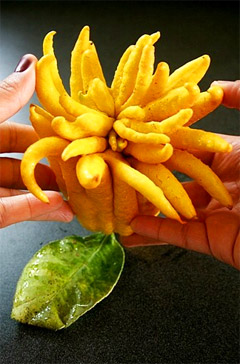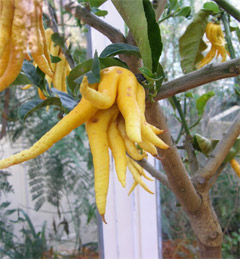|
|
Buddha's hand: Fruit for Good Luck, Happiness and Long Life

Buddha's hand is a fragrant citron variety whose fruit is segmented into
finger-like sections. The origin of Buddha's hand plant is traced back to
Northeastern India or China.
The Buddha's hand fruit has a thick peel and only a small amount of acidic flesh
and is juiceless and sometimes seedless.
Buddha's hand fruit is very fragrant and is used predominantly in China and
Japan for perfuming rooms and personal items such as clothing. The fruit may be
given as a religious offering in Buddhist temples. According to tradition,
Buddha prefers the "fingers" of the fruit to be in a position where they
resemble a closed rather than open hand, as closed hands symbolize to Buddha the
act of prayer.
The peel of the fruit can be candied into succade. In Western cooking, it is
often used for its zest. The inner white pith is not bitter as is usually the
case with citrus, so the fingers may be cut off and then longitudinally
sliced�peel, pith, and all�and used in salads or scattered over cooked foods
such as fish.
Buddha�s hand resembles lemon primarily, and orange secondarily (but don�t
expect sweetness). The pith does not have the inedible sourness of its
peel�which, if eaten, would be like eating a lemon rind�but it is juiceless and
seedless. The pith is identical to the whites of an orange peel, described as
�velvety smooth� with a �delicate flavor� and �tropical overtones.�
Nutritional Value in Buddha�s Hand
1 teaspoon of the rind contains:
-
no fat
-
no cholesterol
-
no sodium
-
no sugar
-
no protein
-
3 kcal
-
13% RDI of vitamin C
-
1% RDI of calcium
-
1g carbohydrage (negligible)
-
1g of fiber (3% RDI)
Health Benefits of Buddha's hand
Modern pharmacological actions
 1. Alcohol extract of Buddah�s hand fruit can significantly inhibit intestinal
smooth muscle; 1. Alcohol extract of Buddah�s hand fruit can significantly inhibit intestinal
smooth muscle;
2. Alcohol extract of hand of Buddha fruit can dilate the coronary blood vessels
and increase coronary blood flow. When in high concentration, it inhibits
myocardial contractility, slows heart rate, lowers blood pressure, and protects
experimental myocardial ischemia;
3. Buddhas hand citrus relieves asthma and eliminates phlegm to some degree;
4. The fructus citri sarcodactylis polysaccharide contained in Buddha hands
fruit plays an important role in supporting immune function. That being said, it
promotes the phagocytic function of peritoneal macrophage, and tremendously
fights against the cyclophosphamide-induced immune dysfunction.
Buddhas hand fruit in herbal remedies
As a common Chinese herb, it is viewed as acrid, bitter, and sour in taste and
warm in properties. It covers 3 meridians of liver, spleen, and lung. Its most
important functions are stretching liver to smooth Qi and harmonizing stomach to
relieve the pain. Main Buddhas hand citron uses and indications are
liver-stomach Qi depression, fullness in chest and rib cage, fullness or
distension or pain in the stomach, reduced appetite and vomiting, and so on.
Recommended hand Buddha dosage is from 3 to 6 grams in decoction.
1. Cough by vital energy and phlegm stagnation. According to Min Nan Min Jian
Cao Yao (Folk Herbal Medicine In Minnan), Buddha hand decoration in the dose of
2 to 3 Qian is a good formula for phlegm-Qi induced cough.
2. Tympanites and swell. According to Lingnan Cai Yao Lu (Records of Gathering
Medicinal Herbs of Lingnan), the combination of Buddha hand citrus and (Hominis
Urinae Sedimentum) can cure tympanites and swell.
3. Leukorrhea. According to Folk Herbal Medicine In Minnan, the hand of Buddha
coupling with small intestine of pig works for diseases of gynecology.
4. Hepatitis A. According to Traditional Chinese Medicine Dictionary, Buddha
citron combining with Bai Jiang Cao (Patrina) treats infantile infectious
hepatitis A.
This herb is rich in nutrients, such as carbohydrates, crude fiber, ash,
limettin, and so on. Hence, it is mostly used for medicinal purposes and made
into tea and essential oil. What�s more, it is often used for dietary therapy
too.
The Japanese and Chinese use the Buddha's Hand for perfuming rooms and their
clothes. It has the smell of violets and osmanthus. The whole fruit is sometimes
used as a centerpiece. It can also be used in many recipes. It can be used in
the place wherever lemon zest is used. The grated rind can also be used in
different foods to add a lemony taste to them. The rind cut into strips can also
be used to make homemade marmalade or candied. It can also be used in
casseroles, souffl�s and soup compotes.
The Buddha's Hand is high in vitamin C. It is used as a general tonic and
stimulate. There are no other known nutrients in the fruit. Moths can be
repelled with the leaves of the fruit. In order to buy a ripe fruit, look for
one that is firm with a sweet fragrance and is blemish free. The fruit will last
up to two weeks at room temperature and refrigerated it will last longer.
In China the fruit is often carried in the hand or simply placed on a table in
the home to bring those who live their good luck, happiness and long life.
Video
Dated 12 March 2014
|
|
|
|
|









